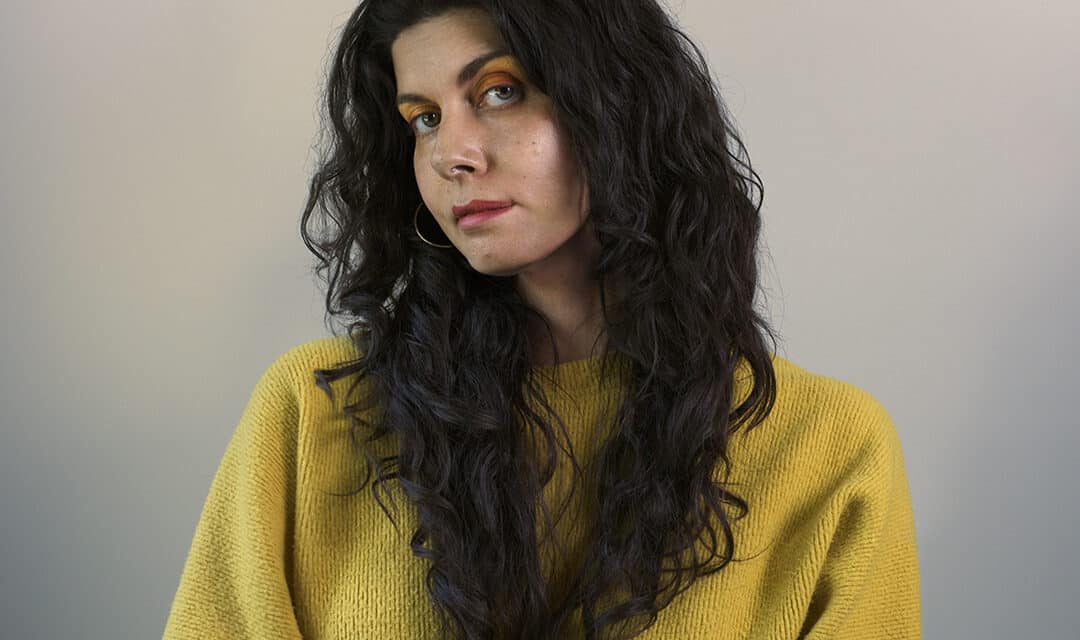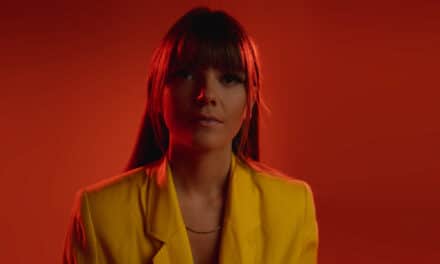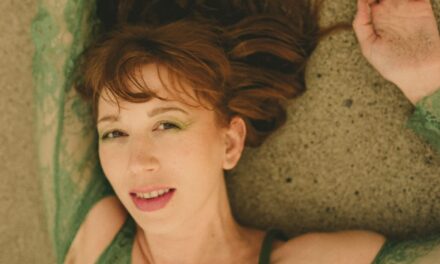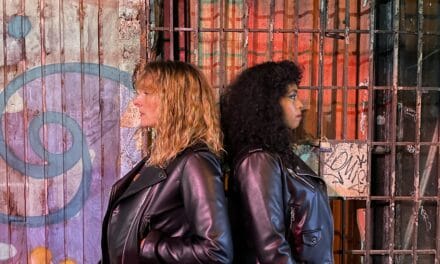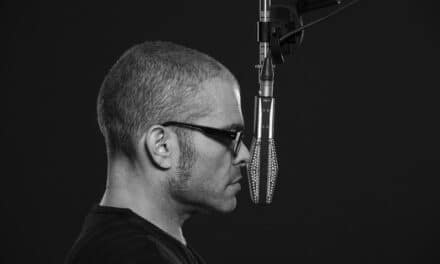For Boshra AlSaadi, making music has always been more than an act of creation — it’s an act of survival. Under the moniker SAADI, the Syrian-American multidisciplinary artist has spent the better part of two decades navigating the intersections of visual art, anti-folk, indie rock, diasporic identity, and now, the deeply personal reckoning of what it means to keep living, and creating, at the end of the world as we know it.
On September 4, SAADI returns with her long-awaited sophomore album, Birds of Paradise, out via Switch Hit Records (pre-order available now). And today, she unveils its devastating and beautiful latest single, “Homo sapiens”, which premiered at Magnet Magazine and is now streaming on all platforms.
Written during what she calls a “post-person” period of her life, Homo sapiens is an unflinching meditation on disability, lineage, and the moral weight of bringing children into an already cruel and collapsing planet. “The difficult decision of whether or not to have children in the face of all they might suffer,” she explains. “How a disability could influence that decision. This song was very painful to write but functioned as therapy for me.”
Recorded between Valis in California and Rosen Sound in LA, the track’s emotional undercurrent is shaped by the haunting analog textures of a Yamaha CS80 synth — a serendipitous detail AlSaadi calls “lucky,” but one that makes the song feel almost otherworldly, like a eulogy for humanity delivered from the ashes.
For AlSaadi, the long path to Birds of Paradise has been anything but linear. Born in Damascus and raised in Pennsylvania, she first made her name in New York City’s East Village anti-folk scene while studying at Cooper Union, eventually co-founding the band Looker before joining indie stalwarts TEEN and Janka Nabay & the Bubu Gang. With those projects, she toured the world, played Bonnaroo, Kennedy Center, and left her fingerprints on some of NYC’s most vital underground art.
Then came her 30s — and a diagnosis of muscular dystrophy, which forced her to stop touring and rethink everything she thought she knew about herself as an artist. What followed was a spiral: a dramatic disavowal of art, a stint as a biology student at CUNY, and what she describes as a disorienting disillusionment with music, politics, religion, and even her own body. “I was underweight, underslept, and miserable,” she recalls.
It wasn’t until producer Chris Coady (Beach House, DIIV) reminded her of who she was — “You’re an artist. You’re a producer,” he told her — that she found her way back to herself, song by song.
The result is Birds of Paradise: a record that takes the destruction and disarray of the past four years — post-truth, post-pandemic, post-mobility — and turns it into something strangely gorgeous. Co-produced with Coady and mastered by Randy Merrill (Taylor Swift, Adele), the album folds together analog synths, programmed beats, guitars, and layered vocals into a series of meditations on domination, populism, feminism, biology, and our fragile, often-futile attempts at control.
“Birds of Paradise is a post-apocalyptic record for me,” she says. “It was culled from the ashes of so much destruction… but it’s also born of a quest for meaning in our disintegrating world.”
On Homo sapiens, you can hear that quest in every note — the quiet rage, the fragile hope, the knowing humor of someone who refuses to stop asking the hard questions. For SAADI, the apocalypse doesn’t sound like an ending. It sounds like an invitation.
Birds of Paradise arrives September 4. Stream Homo sapiens now and pre-order the album via Switch Hit Records.
Birds of Paradise is described as a post-apocalyptic record born from personal, political, and existential upheaval. What was the first spark that ignited this album?
Just before lockdown I had disavowed music and art to become a biologist (!!) enrolling at CUNY and pushing through two semesters of remote hard sciences. I met Chris Coady through our mutual friend Nick Thorburn and soon braved a trip out to LA, where he gifted me an Apollo interface and encouraged me to dive back into recording. I immediately used it to record the song “2 Back Beast” back in my East Village apartment between physics labs and bio exams. I didn’t know it yet, but this would be the beginning of a 3 year recording odyssey, continuing through the pandemic as I quarantined with Chris at Valis (his studio in Glendale) with access to both his expertise and his crazy collection of gear. I dropped out after two semesters and went into the album full tilt, carting my mobile rig around and recording wherever I could for the next few years, ultimately moving to LA after 27 years in New York City.
“Homo sapiens” is a deeply personal meditation on the question of parenthood and disability. What was the emotional journey of writing and recording such a raw song?
This one was especially harrowing. I had to make some difficult decisions that year, ones that I still stand by. Every time I worked on the lyrics, the road I hadn’t chosen would appear before me, a giant “what if?” demanding some kind of reckoning. The music came very easily but lyrically I had to work incrementally. It was painful. It started with a beat from an old Baldwin synth (the only drums on the track) followed by the piano. Deep into the production process I was able to get some distance emotionally and focus on the synth tapestry that underpins the song. I was so happy with the way the it was sounding, the progression, cadence, harmonies, etc. The song ended up affirming those tough choices by virtue of its existence.
You mentioned that creating “Homo sapiens” was therapeutic. How do you balance vulnerability and control in your songwriting process?
As a song takes shape, there is a point where it starts to dictate its own rules, helping you to organize your scattered thoughts. The structures that emerge can be a “skeleton system” (as Janka Nabay used to say) for whatever idea you’re excavating. With “Homo sapiens” I chipped away at the lyrics, getting myself into a state, and ducking out after I was mentally exhausted but satisfied with what I accomplished that day. After a few weeks, there was a song— and I had come a little closer to peace of mind. Now I think it’s one of my best songs because of that vulnerability.
You’ve moved through so many musical spaces — anti-folk, Bubu music, indie rock, experimental pop. How do you see genre functioning in Birds of Paradise?
It changes, adjusting to the needs of each song, with influences culled from all this amazing music in my life. The song “Cowboy in a Ghost Town” is musically an homage to Janka Nabay and includes my attempt at a Bubu beat. “Dead End” is inspired by Debussy’s Doctor Gradus ad Parnassum. “Hollow Body” started as an attempt at emulating Cyndi Lauper. In that case I wanted an uplifting veneer on top of this sentiment of being in a painful feedback loop. The harmonies on the title track are inspired by The Roches. We might have to include post-genre in my list! I have come to accept this eclectic approach as a defining part of my process.
After being diagnosed with muscular dystrophy, you stepped back from touring and even enrolled in biology studies. How did that experience reshape your relationship with creativity and the body?
It ultimately reaffirmed my dedication to the arts and to making peace with my limitations. I had to realign my goals; my body couldn’t tour anymore. I fully immersed myself in the hard sciences: physics, chemistry, biology. I got to see the world empirically for a year and that was a revelation. Still, I was lost without music in my life. In a way, the perceived setback reshaped my expectations and desires, to the point where music-making felt liberating again. I could stop touring and focus on production and songwriting. I always preferred constraints in the creative realm; this is a version of that. For example, I no longer have use of my right bicep—this limits my ability to use a pick, play guitar, and play piano. It pushes me to write more interesting parts within my capabilities, or find what I need sonically in other ways. I have to sit down now when I play live, which has been an adjustment as well. You just work around whatever hinders you and find new ways to express yourself.
The album was recorded in part on a Yamaha CS80, and produced with Chris Coady — known for ethereal, expansive sounds. How did those textures help convey your emotional and philosophical themes?
Chris is truly a sound wizard, and his facility with synths and drum machines pushed the production into this other emotional place. Stephi Duckula at Rosen Sound invited us to come in and record for a day, which was spent adding rare analogue synth textures (including the CS80 and Moog Modular) to various songs on the album. His collection of gear at Valis is so incredible too. I had access to old drum machines, vintage synths, an actual Emulator 1 synth with floppy disks for each sound, a Stratocaster, a piano, a vibraphone, I could go on and on. I was really blessed to be in that situation. I learned a lot about the emotive power of synths by watching him in action.
You’ve called Birds of Paradise “post-truth, post-pandemic, post-mobility, but also post-person.” Can you unpack what “post-person” means to you in this context?
That can mean so many things, right? There was a time when a person’s digital avatar played a minor character in their actual life. Now it’s the protagonist. Like each of us is a little homunculus driving around this giant digital body made up of all the content we curate or create. There’s an unsettling solitude in all that noise. I think a lot of artists have been really affected by it.
There’s a clear thread in your work about resisting domination — whether systemic or personal. How does that resistance show up sonically or lyrically on this record?
I’m really happy to hear that observation! There are subversive elements throughout. “Cowboy in a Ghost Town” is an overtly political song, including a chant I recorded at a Jewish Voice for Peace protest in Hollywood. “Gotcha!” pokes at organized religion. There’s the rejection of motherhood within “Homo sapiens,” or the demand to be seen in “Bottom to the Top.” I could probably list more but it’s good to be a little mysterious…
Your multidisciplinary background (visual art, photography, performance) informs your music in really vivid ways. How do these creative modes intersect for you in this album cycle?
During an arts residency I attended in Washington state, I painted a body of work based on the album, using stained glass as a motif. The paintings make up all the album and single art for Birds of Paradise. Some of them were animated for an upcoming video for the song “Gotcha!” I’m always integrating my other practices into SAADI, whether it’s editing music videos (like “Hollow Body”) or retouching images, or making a visualizer.
Birds of Paradise marks a return after personal loss, disability, political disillusionment, and renewal. What does it mean to you now to reintroduce yourself to the world as SAADI?
I feel more empowered than before, maybe because I tried to walk away and was compelled to come back, driven by personal, political, and existential questions I couldn’t shake. I have something to say. I’m so proud of this album and very excited to continue writing, producing, and recording music for as long as I can!

